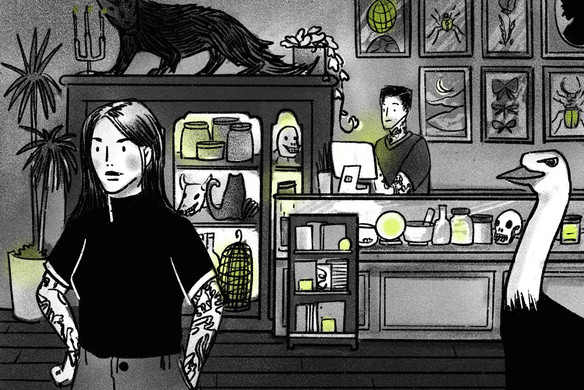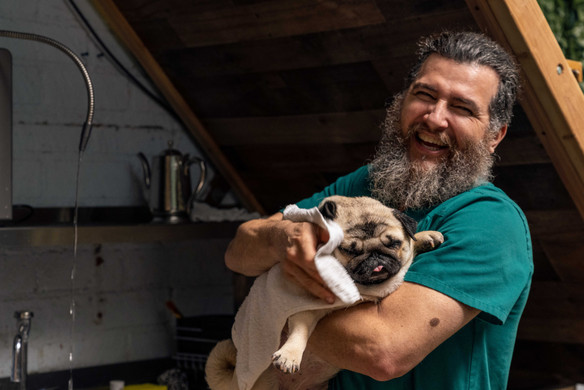Table of contents
Skulls and tarantulas, candles and ouija boards, tarot cards, and mummified bats — this is the stuff of Halloween, and of Rest in Pieces. This oddities and curiosities shop is co-owned by Justin Torone and Alaina Gearheart in Richmond, Virginia, and offers spooky merchandise 365 days a year. It hasn’t always been easy for a store that skews seasonal to stay in business, but thanks to their savvy saving, ability to pivot quickly, and business acumen, the two have successfully run a brick-and-mortar storefront since 2015.
Unconventional beginnings
Ironically, it was a dead animal that brought about Torone and Gearheart’s new life as business owners. In 2013, both in their early 20s, they shared a passion for skulls and horns. But after a year of collecting through eBay and other online retailers, they decided to try their hand selling oddities themselves. “We would literally drive around with gloves and bags in our car and look for roadkill, because that was all money to us in our heads,” said Torone.
One night on their way to dinner, they spotted a dead groundhog on the road and saw their chance. “We made jewelry with some of the bones,” he said. “We sold that to an antique store. We made $100. With that $100, I bought a $50 raccoon skeleton. We made more jewelry with those bones and got to $500, budgeted that and got to $1,000.” It was a start to serving up all things eerie. And after vending at tattoo conventions — another one of their shared interests — Rest in Pieces officially opened up shop.
When spooky season ends — or doesn’t start at all
Torone and Gearheart’s journey founding Rest in Pieces has been full of valuable lessons, like doubling down on a niche can lead to success. “The stranger the piece, the faster it sells,” said Torone. Offering the right inventory has been critical to their continued growth, but it’s something they had to learn the hard way.
“Every business has slow and busy seasons,” said Torrone. “But it was really strange because the first couple of years, October and even the week of Halloween were really slow. And what we realized was that we were competing with Spirit Halloween and Michael’s, all of these big stores. Now we’ve shifted in the sense that we know what those stores are not carrying. They’re not selling sage bundles and real skulls and real bones. Our busy season thankfully is October through January. That’s when we shine.”
Rest in Pieces’s slow season extends from May to August, but Torone and Gearheart do everything in their power to boost sales. “Every August a big oddity expo comes through, and this expo brings like 10,000 people,” he said. “We spend those slower months prepping for the expo. That makes us like half a month or a month’s worth of revenue in a day. We also push our online sales a little more, and we do a lot more events as well.”
In the past they’ve partnered with a herpetology nonprofit to host a session with live snakes, and Torone teaches entomology classes on spreading and pinning butterflies, moths, and insects. “We incorporate different things and adapt to those slower months,” he said. “We haven’t been in business for almost 10 years by just doing the same thing.”
Save, save, save
One thing that has stayed the same, however, is Torone and Gearheart’s expert saving skills. After Rest in Pieces opened, they quickly outgrew their 500-square-foot space. The duo saved aggressively, setting their sights on a new store at 349 South Laurel Street, diagonal from Hollywood Cemetery. “We saved our pennies for a year and a half,” said Torone. “Then we dumped our entire savings into the new shop, the one that we’ve had since 2017. It all went into new furniture, new fixtures, the security deposit, and inventory for a store that was five times the size of what we had.”
When the pandemic hit, Rest in Pieces closed from March to June of 2020, a time Torone describes as a “tough year.” But once the government started rolling out stimulus checks and the push to support local businesses gained traction, things shifted for the better. “We were making twice as much per month as we are now,” he said. “It was this huge period of growth, growth, growth. And so we just saved all that extra money that we were pulling in.”
That money ended up going towards a monumental purchase. The landlord offered Torone and Gearheart first rights of refusal, and by spring of 2022 the building was theirs. Owning a commercial property has its own unique challenges, however. “You have to make sure that you’re financially able to upkeep the building,” said Torone. “It was built in, like, 1910. It’s an old building and it has a lot of really great charm to it, but we also have to put money into it. And so that means having a special savings so that when something does go wrong or if something blows up, we can fix it. We’re saving up to redo our floors.”
The terror of taxes
If slow Halloweens and building ownership don’t phase a purveyor of the peculiar, then what does? One word: taxes. “They absolutely crush you the second you start making money with taxes,” said Torone. “The second you have a really good year or a really good quarter, it’s this feeling of a boot on your head, slamming you back down to the ground. That destroys me every time.”
After talking with fellow business owners about back taxes, however, Torone knows to avoid them. “Every single week, I have a set amount of money that gets taken out of my checking and goes into my savings account. Basically it’s an estimate. So when that quarterly tax payment comes around, I’m just pulling it out of my savings account and I don’t see a hit in my checking.”
Despite the inherently scary nature of taxes, Torone emphasizes the positives. “It’s high highs and low lows all day long, every day, every week. But it’s important to celebrate those highs. So when those little losses come, you just shove them aside.”
Happy haunting
“If there are spirits here, they’re at peace,” said Torone. “I think that we’ve created an environment where everything is respected and appreciated and loved. If there are spirits attached to our human skeletons or any of the supposedly haunted things, they’re all friends.” And though the shop is catty-corner from a sprawling graveyard, Torone and Gearheart haven’t spotted any ghosts … yet.
Finance in Focus: Tricks to Healthy Habits for Your Budget

Aja Evans is a licensed mental health counselor who specializes in financial therapy. She owns and operates a private practice in New York City.
A common misconception is that drive and determination fuel motivation more than anything — when it’s actually about discipline. Small, routine financial habits help you take care of business, even when your motivation is waning.
We hear about budgets in our personal lives, but these conversations are rarely pointed at business owners. This month, I want you to sit down and list out all the expenses required to run your business on a monthly basis. Similar to our personal lives, it can be hard to trim the fat. One reason is because sunk cost fallacy, or feeling like you have to stay the course because you’ve put in time, money, and energy, can keep you stuck. Giving it up feels like more than a failed plan. That’s not the truth — don’t let cognitive bias, or the way your brain creates shortcuts based on your life’s experience, get you down.
Look at what is or isn’t needed to make your business and customer experience great. Then follow these steps: 1. Stop beating yourself up for past decisions that didn’t work out. 2. Understand you’re trying your best — the brilliance of a small business owner is that you’re resilient. 3. Feel the feelings that may come, give yourself grace, and know you’ll continue to learn. After that, cut what needs to be cut.
Habits and discipline go hand in hand. Sticking to your financial goals is easier when you automate tasks into your routine, like saving money and reviewing budgets monthly. And hot tip: You’ll be better prepared come tax time!
Good With Numbers: “My tax bill was $8,000 — double what I expected” said plant nursery owner Kimberly.

Keila Hill-Trawick is founder and CEO of Little Fish Accounting, a boutique CPA firm dedicated to serving micro-businesses through accounting and tax support.
CPA Keila responds to real-life “oh sh*t” tax moments submitted by Square business owners.
Dear Good With Numbers,
As an inventory-based business, my first year I was surprised during tax season to find out my inventory at the end of the year was not an expense but actually deemed income. This doubled the amount I thought I was going to owe to $8,000. Now I slim down my inventory as much as possible before the end of the year and wait until Q1 to bring in my big inventory buys. I buy almost nothing in Q4.
— Kimberly, plant nursery owner, Haltom City, Texas
Let’s talk about inventory, as it’s not income but actually an asset.
When you purchase inventory, instead of being deducted as an expense on your profit and loss (P&L) statement, it’s recorded as an asset on your balance sheet. In other words, inventory is something you own. When you sell your goods, you then report the items as costs of goods sold, which is how they’re ultimately subtracted on your P&L from income received.
So you don’t have to avoid buying inventory — buy it according to business needs, not tax savings! Just be aware of when you’ll be able to deduct it.
![]()









